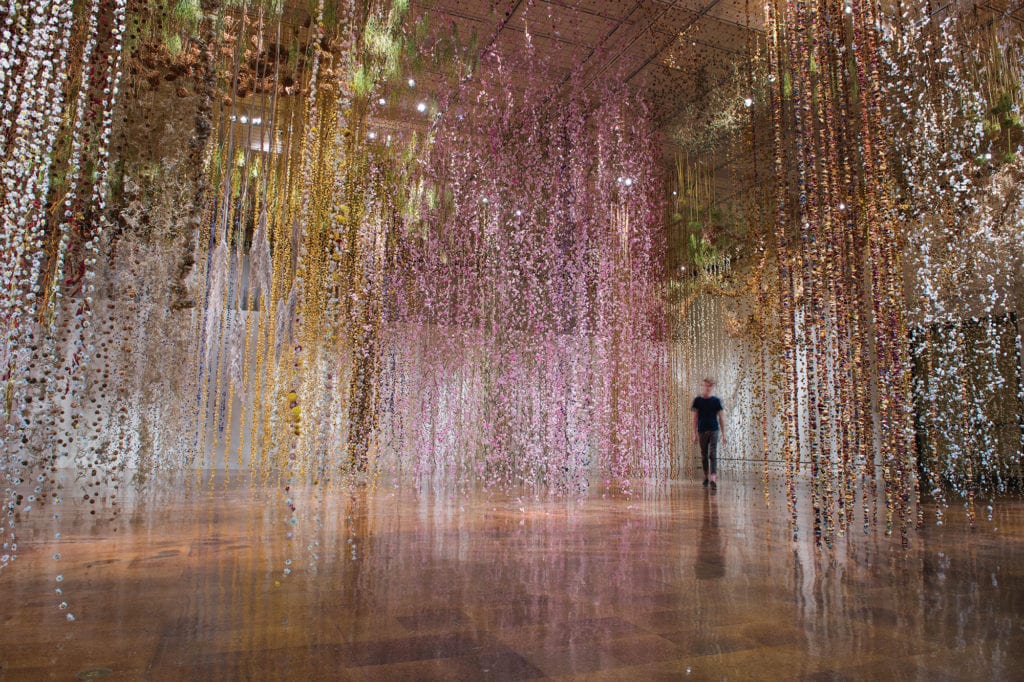
Rebecca Louise Law’s installation, titled Community, at the Toledo Museum of Art, Ohio, in 2018.
Walking through British artist Rebecca Louise Law’s installations is an exercise in experiencing the sublime. Known for her site-specific creations, the artist uses dried and fresh plant material to turn public spaces into immense, immersive indoor gardens in a bid to get viewers to contemplate the relationship between man and nature. It’s a type of magic she’s performed over and over at museums, art galleries and public spaces all over the world—inviting viewers into her monumental colorful artworks, simulating the feeling of walking into a vivid, aromatic painting. For the installation Prometheus, the contemporary artist had hundreds of lilies hanging in test tubes from the ceiling of a giant warehouse. “You could smell the artwork from the street,” she says.
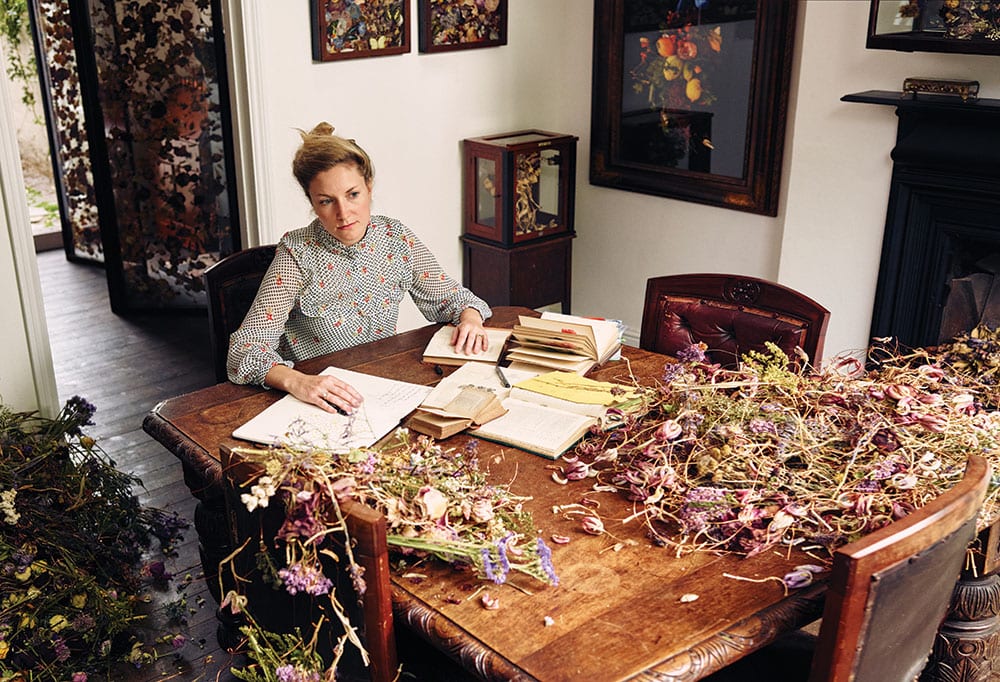
Portrait of the artist at work surrounded by piles of dried flowers. To date, Law has amassed over 1 million dried flowers in storage. Photograph by Fabio Affuso.
Delicate and Surreal
At the La Monnaie opera house in Brussels, a curtain of 5,000 blue-and-green hydrangeas hung from the performance stage, creating waves of color. Law has created installations in New York City’s Times Square, at the Onassis Cultural Centre in Athens, Chandran Gallery in San Francisco, as well as the Kew Royal Botanic Gardens, Royal Academy and the Victoria and Albert Museum, all based in London. Her works often verging on the surreal, Law specializes in the minimalist arrangement of delicate flowers, which, when gathered, create an overwhelming, maximalist effect, often invoking the image of a field of flowers frozen in time. For her installation at the Toledo Museum of Art, the contemporary artist studied the natural history and landscapes of northwestern Ohio. On her first visit to the city, she was struck by the warmth of the locals and decided the theme of the installation would be community.
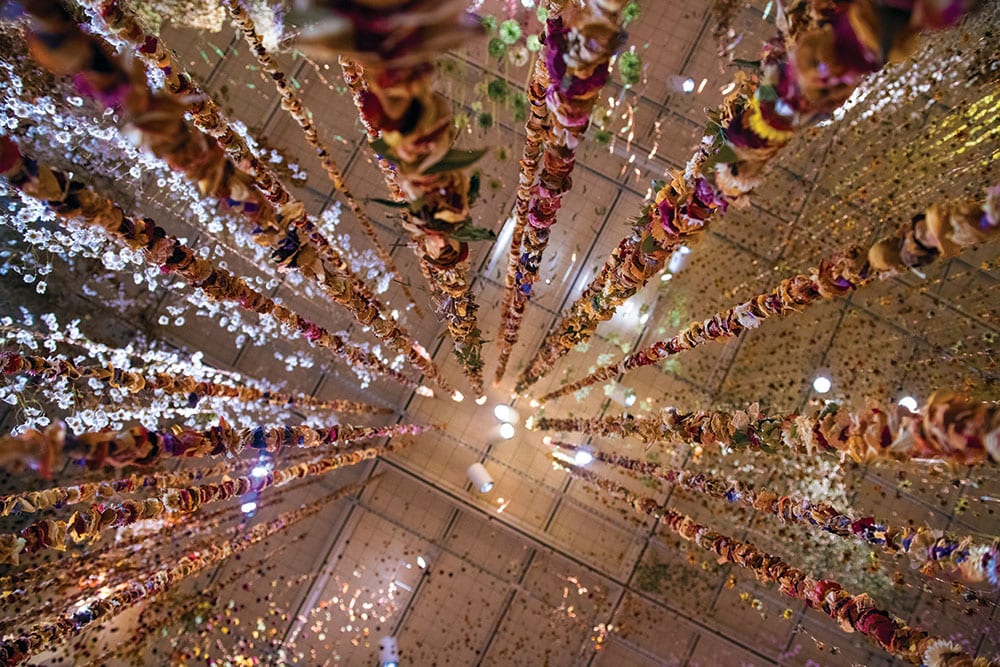
Rebecca Louise Law’s installation, titled Community, at the Toledo Museum of Art, Ohio, in 2018.
Community was her largest installation to date, and was, as many of her pieces are, a massive undertaking. Utilizing 140 species of plants and flowers, 520,000 plant elements were bound together with copper wire, including 10,000 live flowers from a local greenhouse. Nineteen local organizations contributed 1,650 volunteer hours to make Law’s vision a reality, and it took 17 days to install the immersive sensory experience, and Community became a statement on the connectivity of local and global communities.
Born to be a Contemporary Artist
The idea of plants as three-dimensional art is in Law’s blood. She has spent her entire life surrounded by greenery. Her father was a gardener for the National Trust, and she comes from six generations of horticulturalists. Her great-great-great-grandfather was a gardener at Sudeley Castle in Gloucestershire around 1840-50. On her mother’s side, she is a seventh-generation artist. Her childhood memories are filled with flowers like the oxeye daisy and gerbera, but an experience from her youth continues to inform her work. “When I was a teenager, I was struck by the splendor of flowers,” Law says. “The experience of lying in a wildflower meadow, flowers as far as the eye could see and the knowledge that the flowers will pass, and this experience will never be the same.”
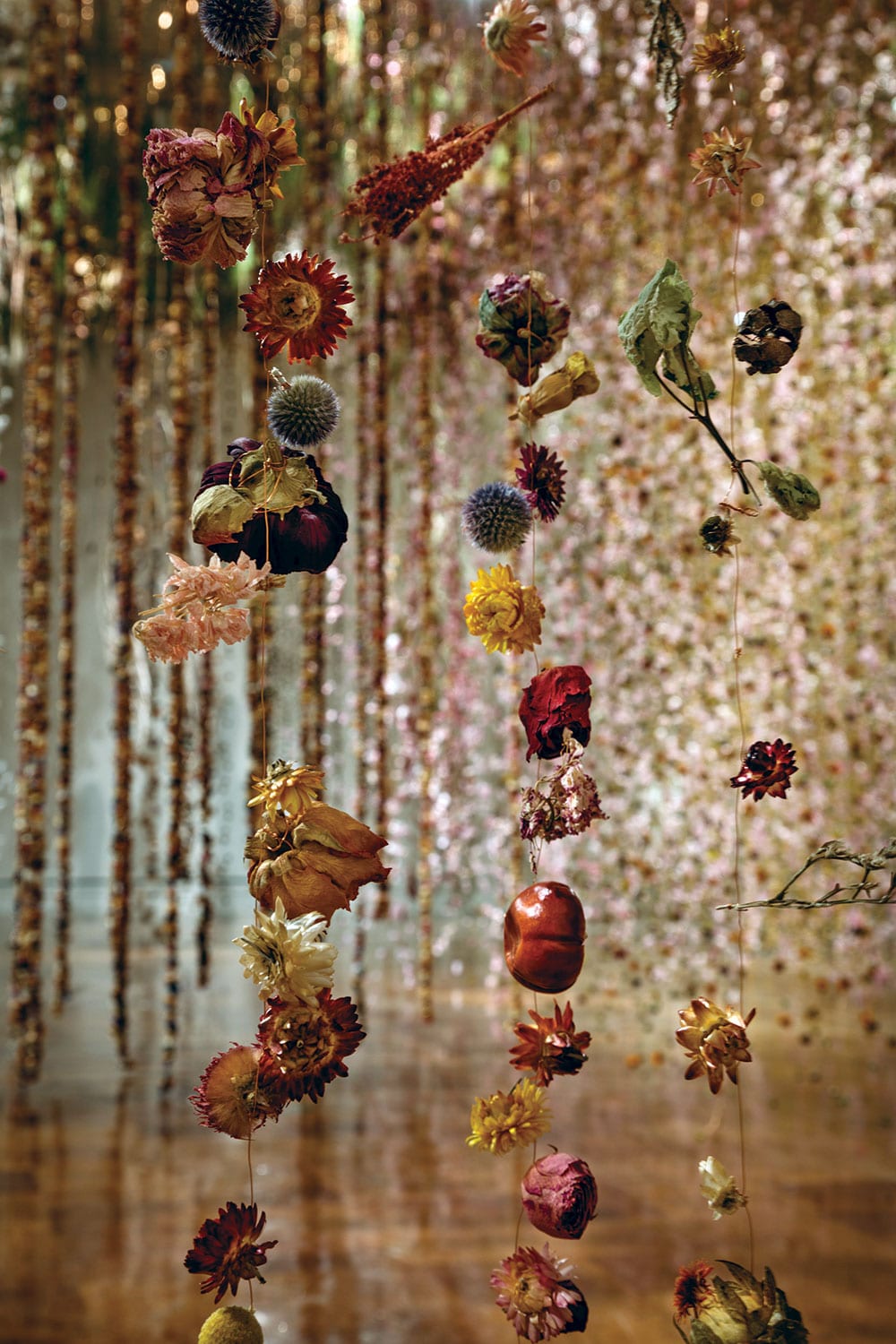
Detail shot of Community created at the Toledo Museum of Art in Ohio, 2018.
She works to recreate that experience in her installations but believes that she is “not quite there.” “I’m often in conflict with the boundaries of traditional craft and fine art,” Law explains of her process. When she decided to pursue her degree in Fine Art at Newcastle University in 2003, she went in as a painter but found herself frustrated by the lack of sensory depth in two-dimensional painting. In her early years, the contemporary artist experimented with a variety of materials, like plastics, wool and even food to find a way to help viewers experience her meditations on humankind and their surroundings. “I wanted to paint in air,” she says, and coaxing flowers into forms became her way of contemplating temporal beauty. Her work explores the intimate relationship between humankind and nature and the emotions certain flowers can provoke; each plant carries joy and sorrow bound up together in one bud.
Interactive Art Installations & Floral Symbolism
In our society, flowers have a variety of uses: we have them at weddings as well as funerals. Flowers are symbols that can evoke a variety of emotions and carry weight in rituals and traditions. Peonies, roses, hydrangeas, and rodanthe’s—all have their own backstories and meanings, and Law often calls on their symbolism for inspiration. In Japan, she created a chandelier out of yellow chrysanthemums, the country’s national flower. “I want viewers to feel like they’re standing in a diamond,” Law said of her White (2016) installation of all-white flowers, a symbol of purity, created with the jewelry brand Forevermark.
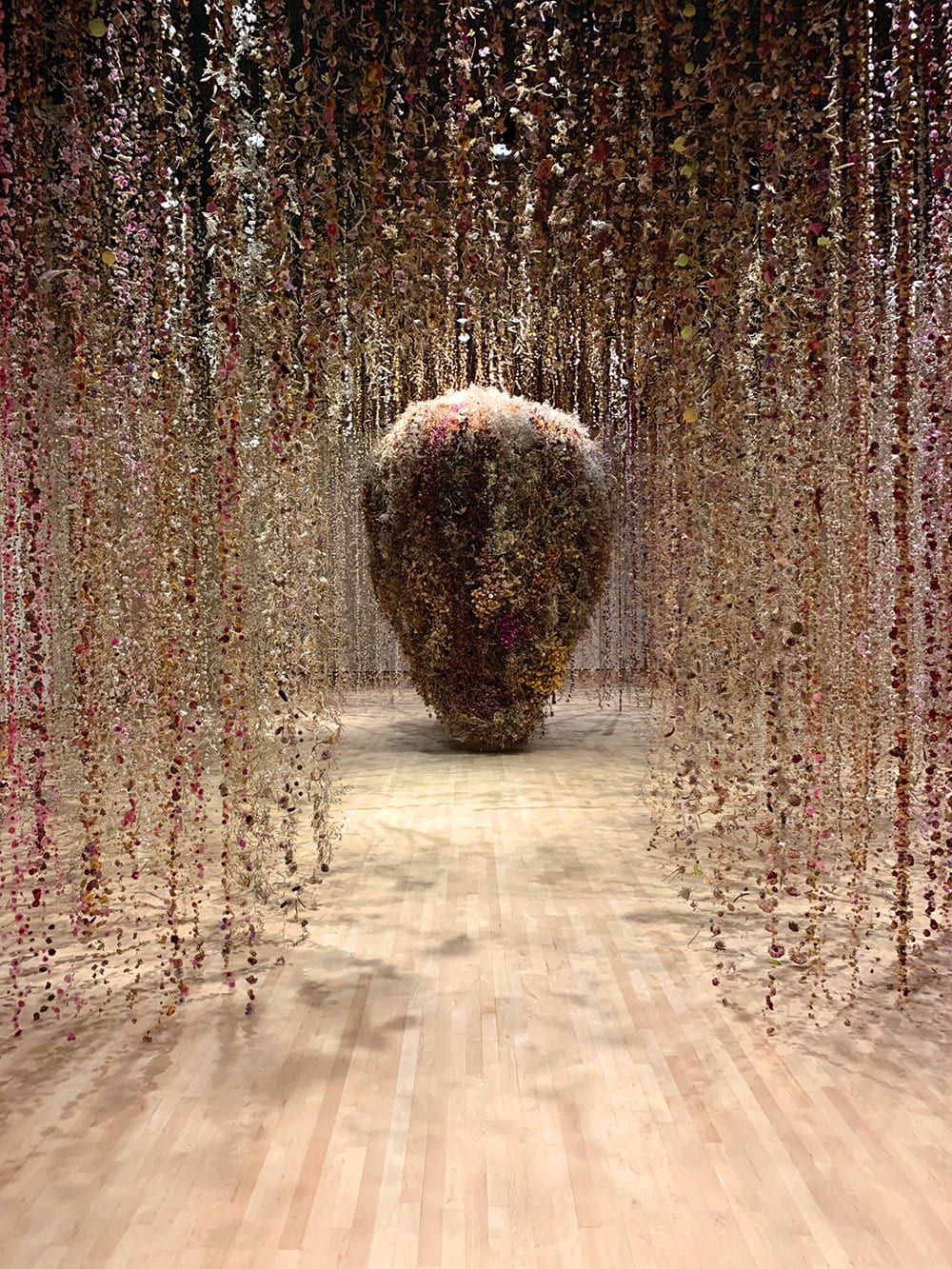
The Womb, created at the Frederik Meijer Gardens & Sculpture Park in 2020.
The contemporary artist doesn’t do many commercial installations any longer but left an indelible mark with the pink peony garlands and chandeliers she created for a Jo Malone London fragrance launch, as well as her collaborations with brands like Jimmy Choo, Max Mara, and Hermès. Decay is also part of the conversation viewers have about her installations. Over time the floating flowers wilt and begin to dry. The vibrant scent of fresh-cut flowers eventually transforms into the weightier smell of potpourri. “I find the smell comforting—the smell of age, perfume and life,” she adds.
As in Life, So in Death
The natural withering of the plant material makes her installations time-based and encourages frequent visits to observe the process of drying. As the plants will change form, color, and texture, the installation becomes a meditation on preservation and finding beauty in decay as well as an appreciation for the lifecycle. Law decided she wanted to bring that concept to a new medium—film. “I love a collaboration,” she says. “It’s always challenging, but I feel it pushes the art into a place that you could have never imagined … I love being out of my depth and learning a new practice.” She worked with director Mike Sharpe on a short film titled The Death of Albine, which was released in March 2018.
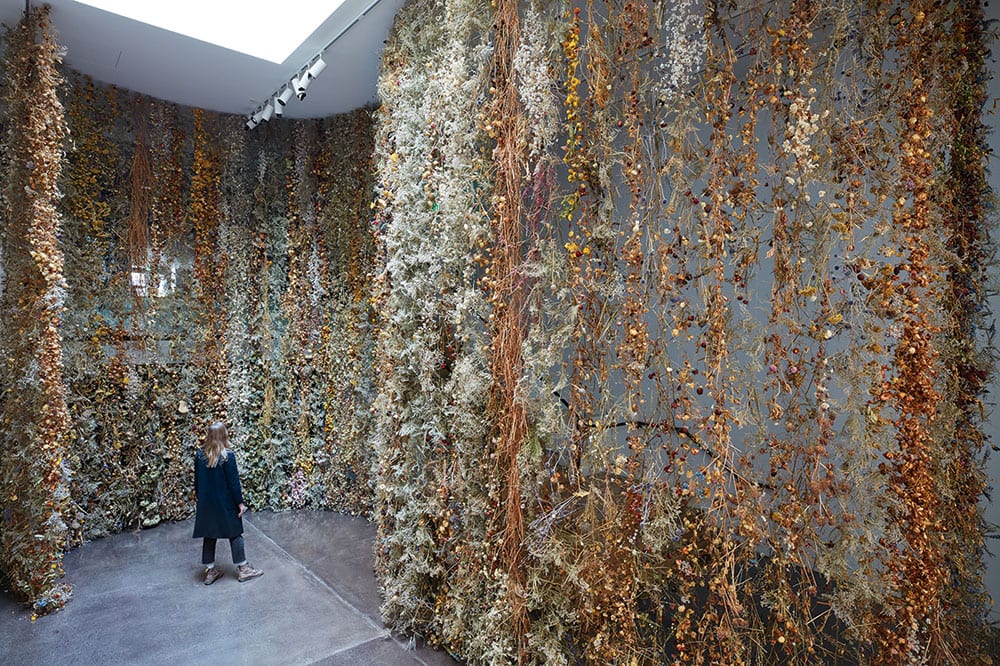
Intertwine, created in the Chandran Gallery in San Francisco, was an interactive installation made of preserved flora from Law’s personal collection. © Markio Reed.
The work was inspired by The Sinful Priest by Emile Zola, a book she encountered in college. The contemporary artist was struck by the way the author used flowers to describe human emotion and physicality through words. In the short film, after the protagonist is abandoned by her lover, she goes to the garden—the site of their affair—and collects enough flowers from the place to create her deathbed. Viewers watch lilies and roses decay before their eyes, a fast-tracked version of what happens in Law’s real-life installations, as the protagonist becomes undone. In the end, everything must return to the dust. That notion became the focus of her 2018 exhibition at bo.lee gallery titled DUST: A Solo Show.
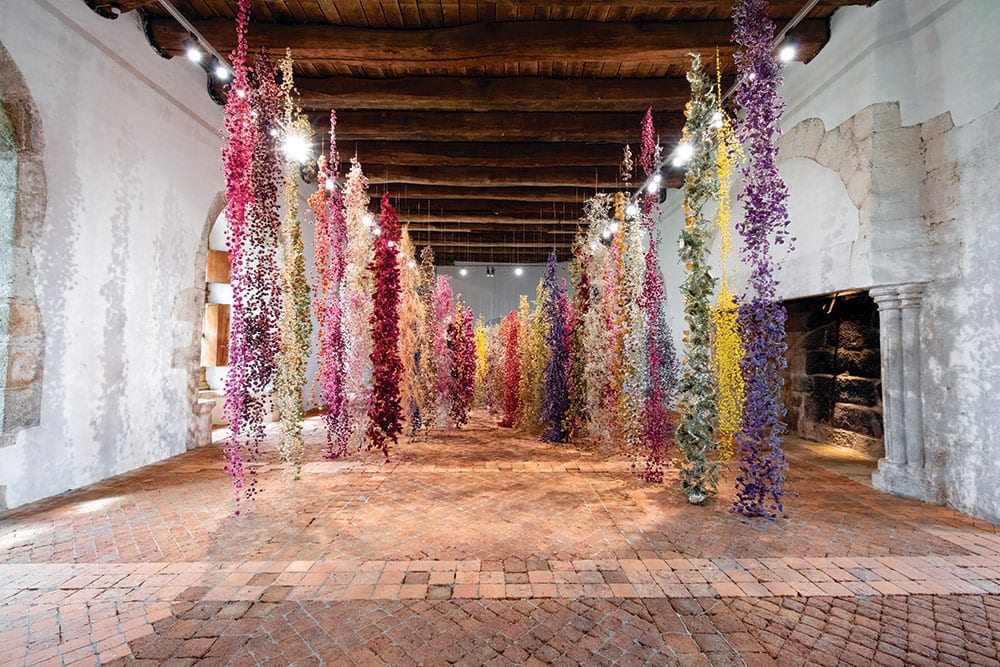
Law’s installation, Banquet, created in La Roche Jagu, France in 2019. © Julien Mota.
Law is constantly adding preserved flowers to her collection. At last count, she had over 1 million dried flowers stored in America and 200,000 in Italy. She even keeps the dust from her exhibitions, and the work for the gallery is one of the best examples of her fascination with the genesis, peak beauty, decay, and return to the earth of natural materials. It was comprised of flower petals, dirt and floral fragments from previous exhibitions across Europe, Asia and the United States. Although most of the world’s public spaces and art galleries are closed due to COVID-19, Law is still working on an exhibition titled Seasons for the Compton Verney Art Gallery in the United Kingdom and another work, titled The Journey for The Cummer Museum in Jacksonville, Florida. Still one dream evades her: she desires to create an exhibition for the Turbine Hall at Tate Modern.
Written by Latria Graham
This article first appeared on Oct 1, 2020
